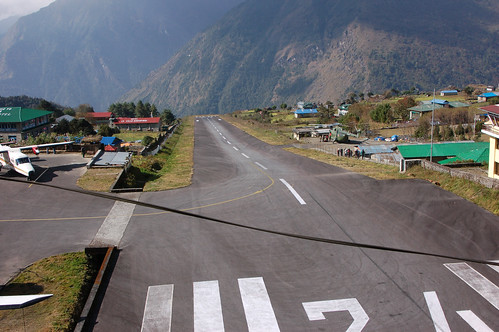
Nepal has only three developed roads and they are all in the south and west of the country. So getting to the eastern -- Everest -- region means for tourists a flight to Lukla ("a place with many goats and sheep") a tiny airport at 9000 feet elevation.. The Lukla runway is very short and angled steeply upward. You land amid a roaring of air resistance on the plane's flaps and squealing brakes.
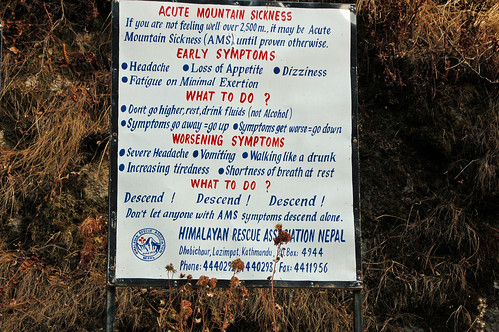
From Lukla onward, the route is mostly up and warnings like this appear. We climbed gradually over several days; I felt no particular altitude effects.
When anticipating this trip, I fixated on seeing the mountains -- but in fact the experience turned out to be as much about the trail itself. The trekking route is, after all, the main highway to a high region where about 20000 Nepalese, mostly of the Sherpa ethnic group, make their homes and live their lives. Everything and everybody climbs up and walks down that route. You are never alone for long as life flows around you.
Oddly for a proper foe of contemporary empires, I was raised on Rudyard Kipling's picaresque novel Kim. Kipling's description of road traveled by the Anglo-Indian boy Kim and his Indian guru/mentor/friend is not a bad fit for this track, though those adventurers were lower and warmer.
Well, maybe the livestock on the Everest Base Camp route is a little less diverse. But the rest is all there.But it was all pure delight — the wandering road, climbing, dipping, and sweeping about the growing spurs; the flush of the morning laid along the distant snows; the branched cacti; tier upon tier the stony hillsides; the voices of a thousand water-channels; the chatter of the monkeys; the solemn deodars [trees], climbing one after another with down-drooped branches; the vista of the plains rolled out far beneath them; the incessant twanging of the tonga-horns and the wild rush of the led horses when a tonga swung round a curve; the halts for prayers (Mahbub was very religious in dry-washings and bellowings when time did not press); the evening conferences by the halting-places, when camels and bullocks chewed solemnly together and the stolid drivers told the news of the road — all these things lifted Kim's heart to song within him.
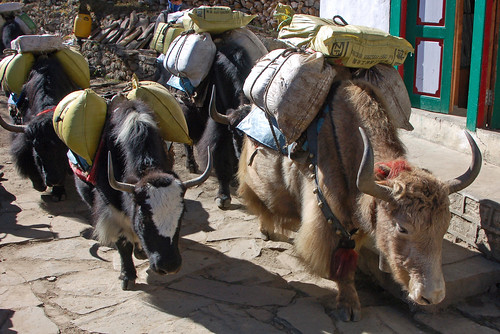
Trains of yaks and their smaller but similar looking relative, a cow-yak hybrid, carry supplies to mountain communities.
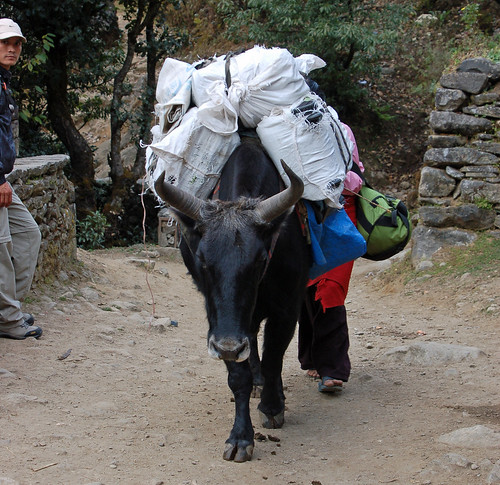
Trekkers scramble to get out of the way. Always move to the uphill side, our guides taught us. Wouldn't want to be knocked aside by an oblivious bovine.
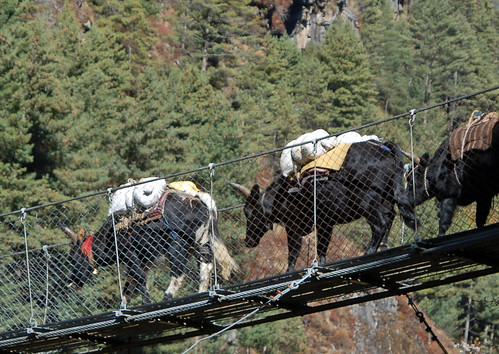
It seems especially wise to give yaks the right of way on the many suspension bridges.

These bridges cross the deep gorge cut by the river Dudh Kosi.
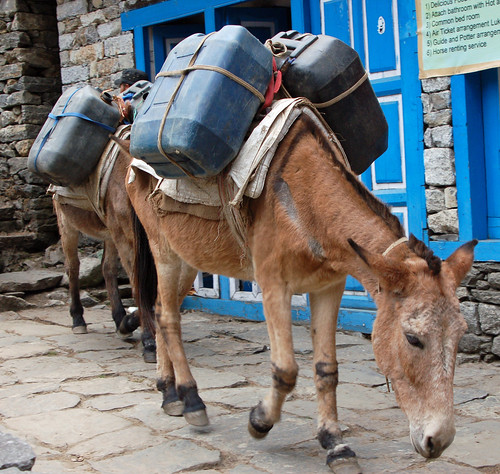
Occasionally the beast of burden is a donkey ...
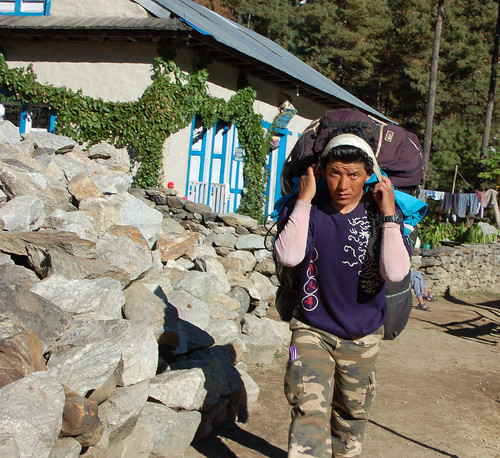
... more frequently, a human porter.
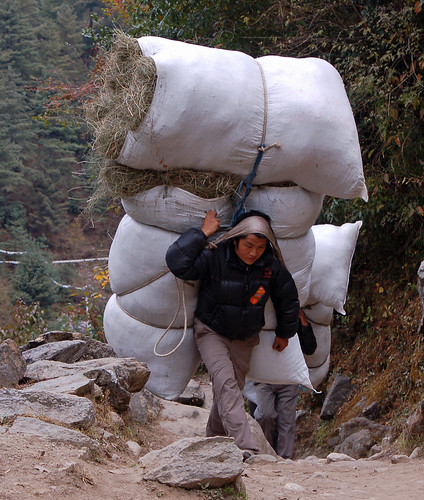
Porters even carry fodder for the yaks.
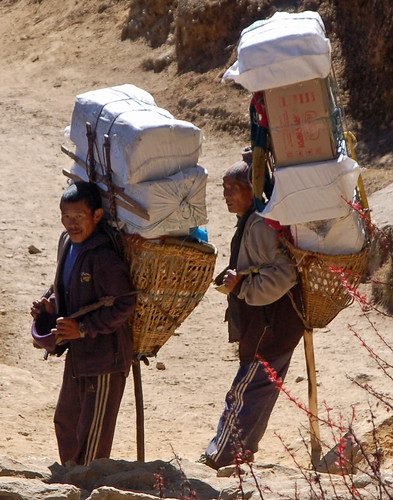
Porters take a break leaning on the same wood staffs they use to balance themselves while climbing up.
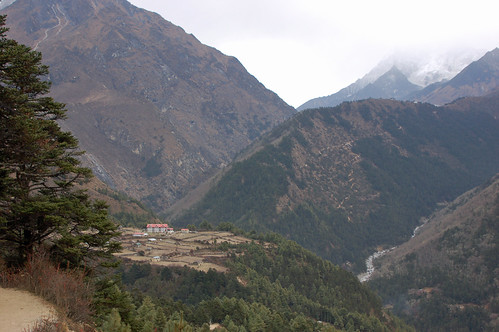
Wherever there is flattish patch of ground, the people of the region have terraced small fields where they grow cabbage, bok choi, carrots, a kind of squash they translate for us as "pumpkin," and ....
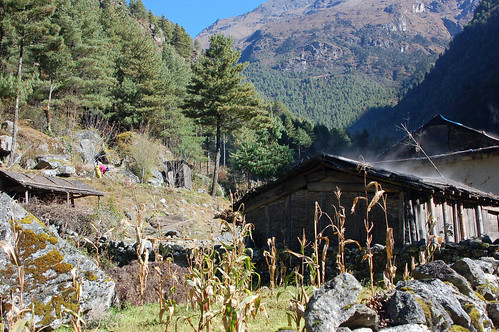
even corn of the popping sort.
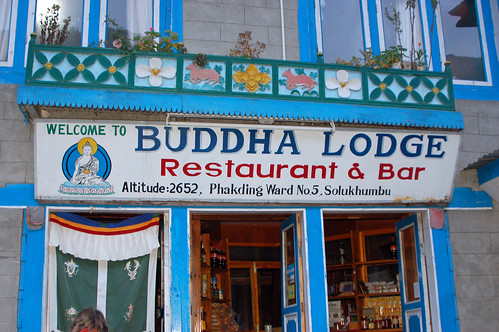
In along the route, there are "tea houses," the rudimentary hostels that offer a platform on which to sleep, a warm stove for guests to gather around, and simple meals of mostly local food. Some facades are far grander than the interiors.
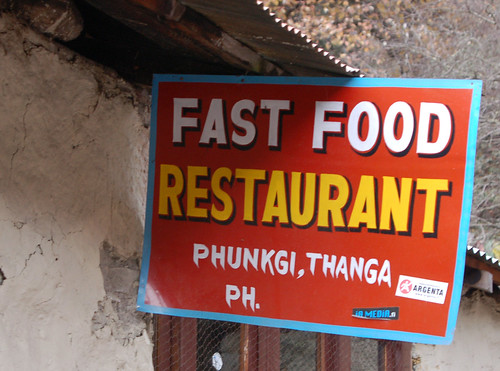
This one is simply a lie -- or perhaps a polite hope. As a rule of thumb, in Nepal all food takes a minimum of 40 minutes to arrive after you order. If it involves eggs or fresh vegetables, someone probably collects them "just in time" for your meal.
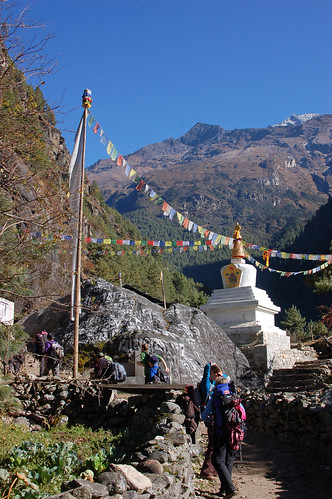
And always, you are reminded that you are trekking the land of a people who interact with the Ultimate by walking, often circum-ambulating their holy places. Ubiquitous prayer flags flap their blessings in the wind.
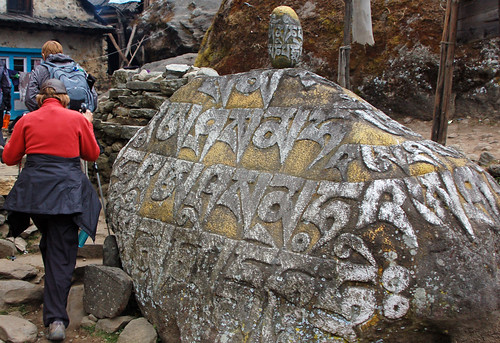
Huge rocks sport embossed mantras. Often there are also prayer wheels, offering themselves for twirling. All such reminders of the Wheel of Life are to be passed or turned clockwise, sending their messages spinning with the universe.
The trail is full of life. I hadn't thought of that, until I walked it.
To see these photos and others from the trek as a slideshow, use this link.
A map that includes route of the trek is here. Please note my disclaimer about what a traveler can or mostly cannot see in someone else's country. Additional posts from my trip to Nepal can be found by clicking on the blog label "Nepal".
2 comments:
I love these pictures. I actually hopped over here from the garbage/Republican post because that one requires a bit more chewing and thinking before responding.
Thanks for sharing so much about your trip. I'm looking forward to reading and seeing more in the days ahead.
I lived at 8,600 ft when I worked at a ski lodge in Utah for three years - many years ago - so have a remote appreciation of the high-altitude warnings. Something you don’t want to mix up with alcohol, which would of course happen all too often at ski resorts.
Post a Comment